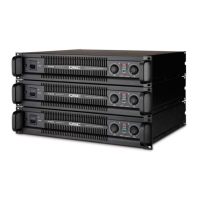PL3 Series Service Manual 13
TD-000274-00 Rev. A
Figure 1.13. Proper IGBT drive signals (with chassis ground
reference )
Figure 1.14. Proper FET gate drive signals with FETs installed (with
chassis ground reference)
1.5 PL380 Service Fixture (continued)
terminal). The voltage is derived from other low-voltage power
supplies, so its presence indicates that the other supplies are
probably good.
If the voltage is not present, then check the other supplies and
associated circuitry to find the fault. For more detailed
troubleshooting, see
Troubleshooting Serious Failures
in
Section 3.1.
3. Power supply sync signal—Connect an oscilloscope to the
sync signal terminal on the service fixture. You can use the
ground terminal on the fixture for the scope probe’s ground clip.
You should see a steady 250 kHz pulse train. The purpose of
this terminal is simply to verify that the clock and divider
circuits are working; the signal here is not clean and has a
significant amount of ringing, but that is not important.
If the signal is not present, then check the clock oscillator
circuit (74HC4060 ripple counter U1, Y1, C3, C8, R4, R10, et al;
on the schematic, see sheet
“AMP CH-A,”
zones C-8 and D-8),
the dividers and complementary logic generators (74HC74 flip-
flops U4:1, U4:2, U7:1, and U7:2; same sheet, zones C-7 and C-
6), and the Schmitt inverters U5:1 and U5:2. For more detailed
troubleshooting, see
Troubleshooting Serious Failures
in
Section 3.1.
4. Low-Voltage Supply Current—Measure the voltages on the
+15 V and -15 V current monitoring points. These terminals
present voltage analogs of the current demand on the low-
voltage supply rails, scaled to 1 volt = 1 ampere. For example, a
voltage of 0.55 volt on the -15 V terminals would indicate that
0.55 A was being drawn from that supply rail.
Typically, the currents drawn should be approximately 400 mA
on the negative rail and 500 mA on the positive when the
amplifier is muted (during the start-up sequence, for example).
When the output FET gates are being driven, the current should
increase to about 500 mA on the negative rail and 800 mA on
the positive one.
If the currents drawn appear to differ substantially from these
figures, there may be a fault in the low-voltage circuitry.
5. IGBT drive—The service fixture allows you to use an
oscilloscope to check the drive signals to the gates of the
power supply IGBTs, Q68 and Q69. Figure 1.13 shows what the
signals should look like. For more details on the IGBT drive
waveforms, please see the
Troubleshooting Serious Failures
section in Chapter 3.
6. FET drive—The service fixture also makes it possible to check
and verify the drive signals to the gates of the output FETs, Q10,
Q11, Q58, and Q59 (see Figure 1.14). However, to get at the FET
gates you must remove the amplifier module (the main circuit
board assembly) from the chassis.
For more details on the FET drive waveforms, please see the
Troubleshooting Serious Failures
section in Chapter 3.

